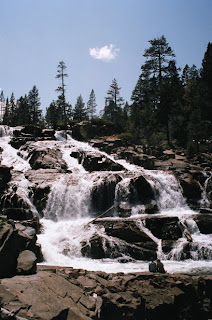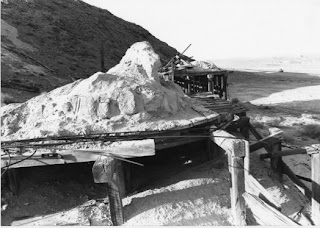
Modjeska Falls, above Fallen Leaf Lake
Tucked in the mountains, a few miles west of magnificent Lake Tahoe, is another body of water that just might be, with apologies to Mark Twain, the second fairest picture the whole earth affords.
Called Fallen Leaf Lake, this picturesque alpine lake rivals its larger neighbor in beauty. In fact, if not for a fluke of nature, namely a small stretch of land that separates Fallen Leaf from Tahoe, the area could easily have been another Emerald Bay.
Fallen Leaf Lake is located five miles west of Highway 89, immediately north of Camp Richardson on Lake Tahoe's southwest shore. A marked and paved road is located directly across the highway from the entrance to the U.S. Forest Service Visitors Center and Tallac Historic Site.
The U.S. Forest also operates a developed camping area at the northeast end of Fallen Leaf Lake. The entrance to the 206-unit campground, which is open from May to October, is located about a quarter of a mile north of Fallen Leaf Lake Road, off Highway 89.
The drive from the highway to the lake is pleasant, passing through large pine trees. About three miles from the turn-off, you travel by a lovely aspen grove and open meadow, both of which are spectacular in the fall, when the aspen leaves have turned gold.
The road narrows as it reaches the east end of the lake and, after passing into a residential area, you catch your first glimpse of the lake. As you drive, you can see incredible scenery, including Cathedral Peak (the southern shoulder of Mount Tallac) rising over the lake, its 9,785-foot crown mirrored in the lake's crystal waters.
I think it is the "mirror effect" of Fallen Leaf Lake that makes the view so remarkable. Rather than enclosing the lake, the reflection of the surrounding mountains seems to stretch into infinity and create a sense of being in a much larger place.
While much of the lake is private property, you can continue to drive to the lake's west end where, in the summer months, Fallen Leaf Lodge offers accommodations and a marina. In the winter, the lodge is closed but you can park and enjoy the marvelous views.
About a half mile from the end of the road (it comes to a dead end at the Stanford Sierra Resort, a private retreat), you can turn west on another narrow (all the roads around here are extremely narrow, so be careful while driving) paved road, lined by large log railings.
This road leads to Lily Lake, a trailhead for hiking into the nearby Desolation Wilderness and an elegant waterfall (which, according to E.B. Scott's book "Saga of Lake Tahoe," is called Modjeska Falls after a famous Polish actress of the late 19th century who visited them).
Frankly, even if Fallen Leaf Lake didn't exist, the waterfall would be worth a visit. Located just north of the road on Glen Alpine Creek, which feeds into Fallen Leaf Lake, the joyous, rolling waves of falling water are an impressive and unexpected sight.
You can park off the road here and hike to the waterfall. From the top, the view of the rapidly cascading water as it falls down the lush canyon is worth noting. Across the creek, you can also see private homes—people fortunate enough to be able to look out on the waterfall any time they want.
The road continues west, paralleling Glen Alpine Creek, for another mile or so to Lily Lake. Opposite the creek, parallel to the road, is a jumbled mountainside of loose boulders and stones.
A concrete bridge marks the end of the drivable road. On the north side of the bridge, you can park and hike a short distance to Lily Lake, a small but photogenic lake literally cupped in the mountains.
The main Glen Alpine Trail leads northwest from here, north of Lily Lake, into the Desolation Wilderness and Glen Alpine Springs, a former resort, located about a mile west after a pleasant walk through the trees.
For more information about camping at Fallen Leaf Campground contact the National Forest Service, 877-444-6777 or go to www.fs.fed.us/r5/ltbmu/recreation/camping/flcamp.shtml.





